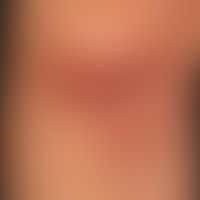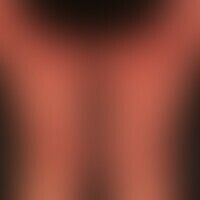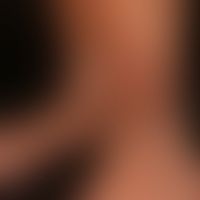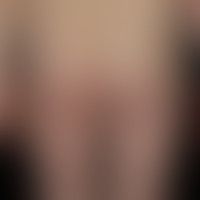
Asymmetrical nevus flammeus Q82.5
Nevus flammeus: congenital, asymmetrically arranged, non-syndromal (no tissue hypertrophy, no orthopedic malposition) large-area (telangiectatic) vascular nevus; characteristic are the scattered borders of the red spots.

Metastases C79.8
Metastasis: Multiple, differently sized, partly reddish, partly darkly pigmented smooth nodules on the thigh in patients with malignant melanoma.

Contact dermatitis allergic L23.0
Acute contact allergic eczema: typical of the allergic pathogenesis of eczema is the blurred, scattered limitation of the inflammatory zone.

Lipodermatosclerosis L94.0
Hypodermitis: extensive reddening and induration of the lower leg. Painful if finger pressure is applied firmly. The tissue can be dented by prolonged finger pressure.
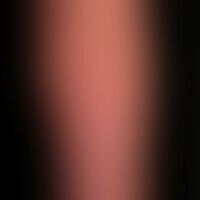
Acute generalized exanthematous pustulosis L27.0
Pustulosis, acute generalized exanthematous: acutely occurring erythrodermal exanthema with histologically proven subcorneal pustular formation in a 62-year-old patient. Exfoliative (coarse lamellar) scaling. massive swelling of the lower legs.
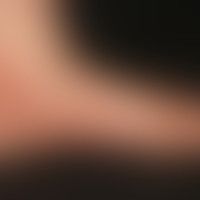
Psoriasis palmaris et plantaris (plaque type) L40.3
Psoriasis palmaris et plantaris (plaquet type): sharply defined, homogeneously red scaly and itchy plaques on the soles of the feet, spreading medially to the edge of the foot and the lower leg.
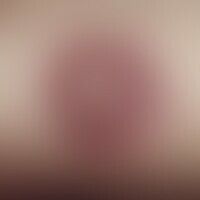
Bubble
bladder. flaccid bladder with a fixed drug reaction. 43-year-old patient who first developed an itchy and slightly painful erythema after taking an anti-inflammatory drug. bladder formation for two days. large, flaccid, brown-red bladder which developed on a brownish-red plaque. the colour of the bladder was caused by haemorrhagic clouding of the bladder contents.

Contact dermatitis toxic L24.-
Contact dermatitis toxic: sharply defined, large-area, acute, itching and burning dermatitis, 6 hours after application of an ointment containing dithranol.
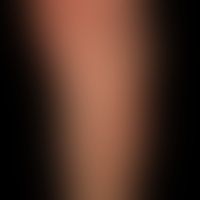
Erythema anulare centrifugum L53.1
Erythema anulare centrifugum: Large, polycyclically limited, asymptomatic broad erythema stripes on the upper and lower leg of a 62-year-old woman.

Hypertrophic Lichen planus L43.81
Lichen planus verrucosus: Symmetrical infestation of the lower legs, ulcerated in places.
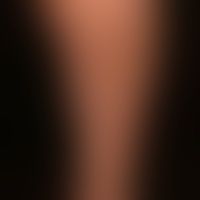
Pityriasis lichenoides (et varioliformis) acuta L41.0
Pityriasis lichenoides et varioliformis acuta: acutely occurring "colorful" exanthema with differently sized papules measuring 0.2-0.8 cm, erosions, and encrusted ulcers.
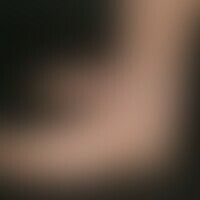
Lymphedema, type nonne-milroy Q82.0

Pyoderma gangraenosum L88

Ulcer of the skin (overview) L98.4
pyodermic ulcer of the skin: moderately deep, large ulcer; characteristic are the circulatory (as if grazed) borders. ulcer smearily documented. cultural evidence of klebsielles and pseudomonas aeruginosa. the cause is a care error; no known underlying disease.

Primary cutaneous B-cell lymphomas C82- C83
Lymphoma, cutaneous B-cell lymphoma. multiple, since 3 months increasingly growing, chronically dynamic, brownish or reddish-livid, flat, indolent, coarse, slightly scaly nodes and plaques. general symptoms: lymph node enlargement, splenomegaly, involvement of lung, liver, stomach and bone marrow.
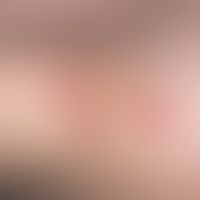
Eosinophilic granulomatosis with polyangiitis M30.1
Churg-Strauss Syndrome. circumscribed, borderline red, in the centre brown-yellow (here beginning of infiltrate formation and regression), in the area of the red areas rough, moderately pressure tolerated plaques and nodules in a 40-year-old man. known allergic bronchial asthma and seasonal rhinitis allergica. rennet: eosinophilia 45%; IgE >1000U/ml

